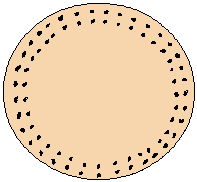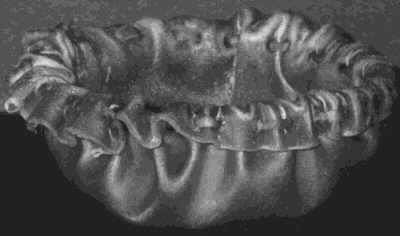Cooking "Clan of the Cave Bear" Style!
Ayla was slicing pieces of yam to put into a skin pot that was
boiling over a cooking fire.
Clan of the Cave Bear by Jean M. Auel (page 140)
While looking for a project to explore for an archaeology course at
Simon Fraser University (Arch 372, taught by Michael Wilson)
I recalled that I had read somewhere that
cooking could be done in a hide container over a fire. When
I called my sister in Hope, British Columbia, to inquire if I could
use her land to build a fire on, she informed me that I had probably
read this in Clan of the Cave Bear. I bought a copy and
fortuitously flipped directly to the above quote on page 140.
Inquiries to knowledgeable persons failed to yield any knowledge
of this method, and a query to Jean Auel to date remains unanswered [April 26, 1995: received letter from Jean Auel, but no specific references as they are buried in her research notes, and she is hard at work ~ good news Earth's Children fans! ~ on book 5.]
Looking for information on construction of such a pot, I came
across the book Plains Indian and Mountain Man Arts and Crafts:
An Illustrated Guide, by Charles W. Overstreet (1993). Herein I
found information on the difference between rawhide and tanned leather,
and several projects, none of which were a pot, but interesting for construction
methods.
I ordered two half hides of rawhide. Overstreet's book had not prepared me for what I picked up at the Greyhound parcel depot two rolls
of a stiff material not unlike plastic! I had thought that I would essentially be making a couple of leather bags, and that rawhide was simply a more robust form of leather.
Construction
Two pots were simply constructed from a single piece of skin
each. The first step was cutting out circular pieces which would
eventually be attached to metal rings purchased from Tandy Leather
in Vancouver. Had I chosen to go all the way with an accurate
reconstruction of a hypothetical Neanderthal pot, the rings could
possibly have been fashioned from green willow (Overstreet, 1993).
However, my main concern was to test whether this method of cooking
was indeed possible.
Due to the difference in size of the half-hides and their irregularities,
one pot would have a diameter of 14", the other of 18".
There is a mathematical correspondence between the diameter of
the circle cut from the hide, and the diameter of the ring it
is to be attached to to form the mouth of the pot. Unfortunately,
not being a mathematician, I used trial and error, starting with
roughly twice the diameter of the ring and cut back from there,
winding up with approximately 24" for the 14" ring and
28" inches for the 18" ring. The 14" inch was
the first made and the diameter I finally arrived at made it a bit
deeper than what I'd envisioned, and it had a 'scrunchier' (more
pleats) rim than the 18" pot I created subsequently. Thus
I called it 'the ugly pot', and the 18" one 'the good pot'.
To construct them I first drew circles of the incorrect diameter (2X) on the rawhide, also taking care to mark points 1/3 of the circumference apart around the edges for support thongs to be attached later, and then cut the circles out using Wiss Metal Master tin snips ("Made from special molybdenum steel, the non-slip serrated jaws cut up to 18-gauge low carbon cold rolled steel."). I marveled that anyone could have worked with this material using only stone tools, but I also suspect that necessary cutting was either done prior to it drying, or else there was water enough to spare nearby to soak it in. That's the next step. For my purposes the bath tub served well enough for soaking the rawhide circles.

I made rawhide strips for attaching the hide to the rings. These are easily made from scrap, starting from the edge of a piece and cutting around in a spiral pattern towards the center. This then needs to be soaked as well to make it pliable enough to work with.

The next step was to make a dual set of holes around the circumference, as well as three extra sets of two for the support thongs at the points previously marked.
Then I pressed the circle into the ring and began attaching it.
 The long rawhide 'string' went through one hole, under the
ring, then through the corresponding hole in towards the centre.
From thence it went over to the next hole, through and under
the ring to the corresponding hole and through towards the outside.
And so on, stopping only a moment at the support holes to attach
a thong ring, until the pot was complete and ready to hang-dry
by the three thong rings.
The long rawhide 'string' went through one hole, under the
ring, then through the corresponding hole in towards the centre.
From thence it went over to the next hole, through and under
the ring to the corresponding hole and through towards the outside.
And so on, stopping only a moment at the support holes to attach
a thong ring, until the pot was complete and ready to hang-dry
by the three thong rings.
 Unfortunately, I lacked the wit to take clear pictures of the
pots prior to their exposure to fire, but I did make a small (5"
diameter) trial pot, shown here.
Unfortunately, I lacked the wit to take clear pictures of the
pots prior to their exposure to fire, but I did make a small (5"
diameter) trial pot, shown here.
This has roughly the proportions of the good pot, perhaps a little
shallower. I wanted the pots to be wider than tall on the premise
that cooking would be more efficient if a wider area was exposed
to the flames.
Method
The first trials took place on Sunday the 10th of March,
1996 at Rosewood Gardens (a garden centre) in Hope, British Columbia,
the proprietor of which is my sister Betty.
 The pots were suspended over a fire from a tripod constructed
of bamboo. While Auel's Neandertals wouldn't have had access
to this material, it is strong and readily available when scavenging
around a garden centre, since such poles are used as supports
for plants. The circular thongs on the pot were attached to leather
thongs which in turn were attached to a wire ring with a hook on it (another material
Neandertals wouldn't have had access to, but since the home of
my sister and her partner is on the site of the garden centre,
coat hangers were easy to scavenge as well). The pot could be hung from a ring
attached to
another long thong, this also of leather, which passed through
a metal ring secured to the top of the tripod. The tripod itself
was held together with a strip of rawhide tied wet so that when
it dried it bound everything quite securely. On one leg of the
tripod was a metal loop (again coat hanger) to which the long
thong could be attached, and the height of the pot could thereby
be adjusted.
The pots were suspended over a fire from a tripod constructed
of bamboo. While Auel's Neandertals wouldn't have had access
to this material, it is strong and readily available when scavenging
around a garden centre, since such poles are used as supports
for plants. The circular thongs on the pot were attached to leather
thongs which in turn were attached to a wire ring with a hook on it (another material
Neandertals wouldn't have had access to, but since the home of
my sister and her partner is on the site of the garden centre,
coat hangers were easy to scavenge as well). The pot could be hung from a ring
attached to
another long thong, this also of leather, which passed through
a metal ring secured to the top of the tripod. The tripod itself
was held together with a strip of rawhide tied wet so that when
it dried it bound everything quite securely. On one leg of the
tripod was a metal loop (again coat hanger) to which the long
thong could be attached, and the height of the pot could thereby
be adjusted.
The Icons below will guide you to the other Cooking Clan of the Cave Bear Style Pages |